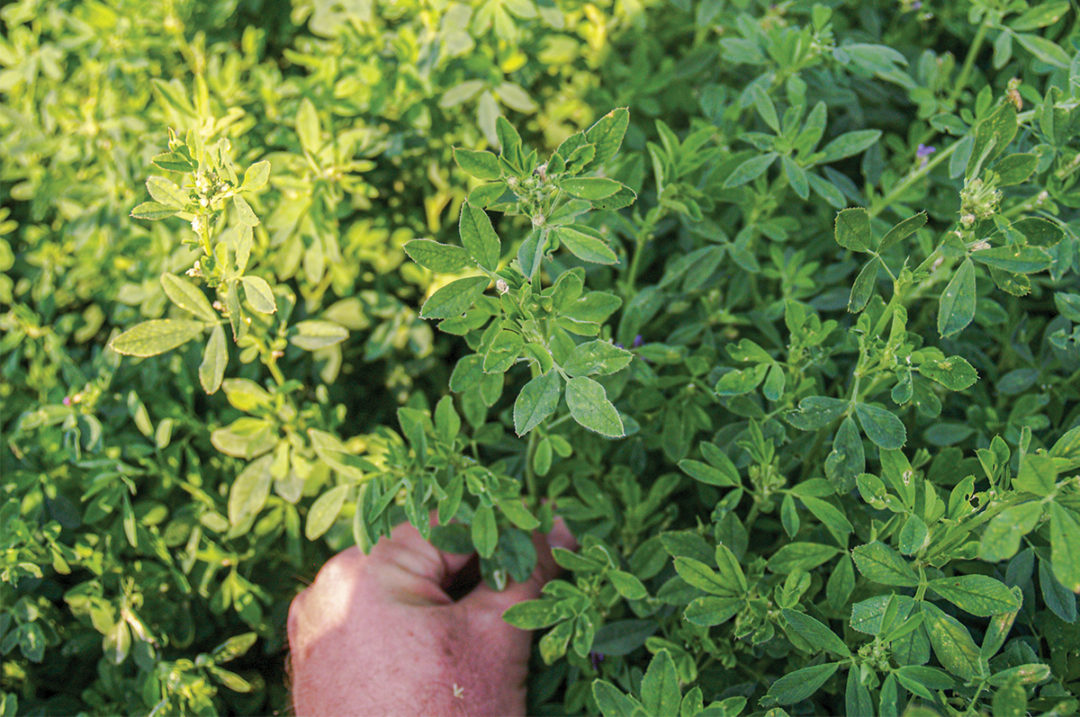A University of Idaho (UI) researcher discovered a previously unknown virus in alfalfa samples taken from a Magic Valley field and is conducting tests to determine if the disease poses a threat to farmers.
UI plant virologist Alexander Karasev took the samples in 2020 while collecting symptomatic foliage in a field at the future site of Idaho CAFE near Rupert. Karasev named the newly discovered disease Snake River virus, after the Snake River Valley in which the field is located.
Karasev and Erik Wenninger, an entomologist with the Kimberly Research and Extension Center, recently received a three-year, $300,000 USDA National Institute of Food and Agriculture grant to study whether the virus is economically important for growers, how it’s transmitted, foliar symptoms of infection and the range of host crops it can infect.
Karasev chose the Rupert field for his sampling due to the prevalence of foliage with common symptoms of viral diseases, including mosaic leaf discoloration and vein clearing. He was seeking to test a new diagnostic genetic sequencing methodology, known as deep sequencing, and associated laboratory equipment. Researchers with the National Center for Biotechnology Information in Maryland compared Karasev’s results against their database and determined it was a new virus.
The discovery is detailed in the paper “A Novel Flavi-like Virus in Alfalfa Crops Along the Snake River Valley,” published in the June 2022 issue of the journal Viruses. In addition to Karasev, authors of the paper include Wenninger, UI entomologist Jennifer Dahan and Gardenia Orellana, a UI Extension research specialist in plant pathology – and National Center for Biotechnology Information researchers Yuri Wolf and Eugene V. Koonin.
“Alfalfa is one of the largest crops grown in the state but is one of the least studied of all of the major crops in the state,” Karasev said. “The production of alfalfa has special characteristics that make it of interest to me. You have a crop that stays in the same place for four years. It acts like a sponge – any type of pathogens and diseases tend to make a stop in this crop.”
Flaviviruses comprise the genus that includes yellow fever and had never previously been found to infect plants. Snake River virus shouldn’t threaten human health.
Based on subsequent testing of Magic Valley fields, Snake River virus is widespread within the region. It’s possible it’s an ancient virus that’s flown under the radar and was only recently discovered thanks to new diagnostic technology.
“Very likely, based on the analysis of our collaborators, this virus may be the founder of a new taxon of flavi-like viruses,” Karasev said. “It’s always interesting and always fun to see something people didn’t see before.”
Testing samples from the Rupert field also confirmed infections by six other viral diseases known to infect alfalfa. Four of the diseases are transmitted only by seed and are considered benign, causing no known symptoms. Two of the diseases – alfalfa mosaic virus and bean leafroll virus – can be transmitted by aphids and may be contributing to diminished yield and quality in older alfalfa plantings. Karasev hypothesizes that the increase in virus pressure may be a key reason why alfalfa production diminishes by the fourth year in production, leading most farmers to rotate to a different crop.
“The assumption was viruses in general caused very little harm to alfalfa,” Karasev said. “We’re trying to get some data to confirm or refute it. Until you start studying it, you may not realize it’s a problem.”
Karasev suspects Snake River virus is spread by thrips. At Karasev’s request, Wenninger collected samples from the university’s research fields in Kimberly. Alfalfa foliage and some thrips Wenninger collected from Kimberly were confirmed to be positive for Snake River virus. Because positive samples were found at locations 50 miles apart and on opposite sides of the Snake River, Karasev suspects the virus is widespread in the region.
Wenninger plans to have a master’s degree-seeking student research if the virus is indeed transmitted by thrips. The master’s student will also apply insecticides in plots for comparison against untreated checks to assess how Snake River virus and other viruses affect alfalfa yield and quality, as well as the efficacy of treatments at controlling thrips, aphids and other insect vectors.
“That’s the purpose of this [USDA NIFA] grant – to see the effects of various alfalfa viruses on the quality of hay,” Karasev said. “If we can suppress and manage these viruses, maybe we can increase the quality and economic efficiency of hay production.”



.jpg?height=auto&t=1713304395&width=285)


